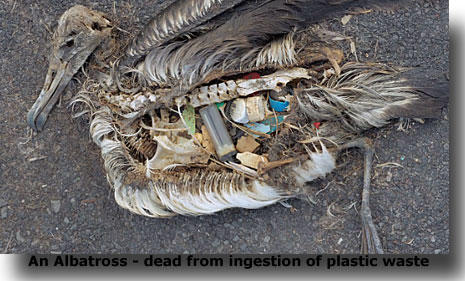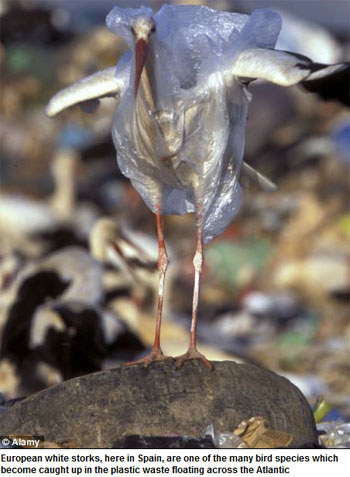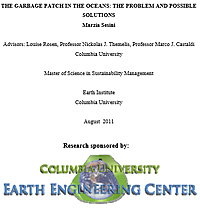 |
 |
|
This is a special report by Chris Ingram, Editor of Unionsafety website; written in a personal capacity: With the issue of plastics and the terrible price being paid by our planet and it’s wildlife hitting the news this week, the stark and appalling image below should bring a tear and commitment to us all to review our use of plastic products, wrapping and to the use of plastic shopping bags. With three huge circular floating dumps of plastic waste, some estimated as 200 miles across now present in the Atlantic, Pacific and Indian Oceans; the danger to wildlife has so far been totally underestimated. They're like spinning galaxies of plastic rubbish, populated by billions of smaller trash islands that may be hidden underwater or spread out over many miles. This image comes from a powerful and blunt video which has been released by Like giant plastic icebergs, it is considered by many to be just the tip of what it really contains. With an estimate of over 64,000 pieces in the Atlantic 'Plastic Galaxy' alone, they break down over time into minute pieces of plastic falling to the see bed or eaten by birds and wildlife unknowingly. On the sea bed, the damage done to micro-life is unknown. A study done over a 22 year period reports that more than 64,000 individual plastic pieces were collected at 6,100 locations sampled yearly over the course of the study. A plankton net was used to collect plastic debris as well as biological organisms at each station. The researchers from the Sea Education Association (SEA), Woods Hole Oceanographic Institution (WHOI), and the University of Hawaii (UH) has published the results in the journal Science "We now have the first long-term, regional-scale scientific study of this phenomenon," says Don Rice, director of the National Science Foundation (NSF)'s chemical oceanography program, which funded the research. "This unique study leaves us with a big mystery and a haunting question, however: What happens to all that plastic once it gets to the central gyre [current]? And how does it interact with deep-sea biology?", he added SEA scientist Kara Lavender Law, the Science paper's lead author commented: A surprising finding is that the concentration of floating plastic debris has not increased during the 22-year period of the study, despite the fact that the plastic disposal overall has increased substantially. The whereabouts of the "missing plastic" is unknown. "The analysis provides a robust scientific description of the extent of plastic pollution to date, which can be used to make better management and policy decisions, and to inform popular perceptions of this issue," says SEA Dean Paul Joyce.
"I think some of the big questions are colonization: what actually lives on these pieces of plastic?" says scientist Chris Reddy of WHOI, a co-author of both papers. "To what extent are ocean currents moving the small life on these plastic particles around the ocean?" The latest scientific deployment to study the plastics in the north Pacific Ocean concluded in November 2012 and was a second study done by the SEA.
Whilst the damage to marine life is bad enough and somewhat still remains unquantified, that which is blatantly evident is the toll of death amongst sea going birds as a result of encounters with plastic waste. Through entanglement in plastic bags, rings, and ropes to the ingestion of smaller particle of plastic waste; the situation is now out of control. Not only at sea, but with the sheer amount of plastics ending up in land-fill; birds are dieing as a result. Furthermore, landfills sited nearby rivers and in coastal areas coupled with illegal dumping, littering and ocean-based dumping have the potential to introduce plastic wastes into the oceans. The ecological impacts of the ‘Oceanic Garbage Patch’ according to Earth Institute Columbia University in the USA, range from over a million sea-birds and one hundred thousand marine mammals killed by ingestions of plastics or entanglement, to economic impacts estimated between US$1000million and US$ 3000 million in beach cleanups (excluding volunteering efforts), tourism losses, and damages to fishing and aquaculture industries. Their study shows appalling levels of plastic pollution in our planet's oceans! The findings from the study were compiled from a combination of mathematical and physical models estimates and data from expeditions. * There are potentially five Garbage Patches scattered globally, located in the North and * The total amount of plastic garbage estimated is 36,000 ton, unequally dispersed. The data results in 9,064 ton of garbage plastic in the North Atlantic and 20,240 ton in North Pacific. * The model estimation results in 2,590 ton of marine plastic debris in the South But perhaps the most damning evidence of all has been gathered via video and photographic means, and shows bluntly, the terrible consequences of irresponsible human activity for our planet and its wildlife. The Midway Media Project is a powerful visual journey into the heart of an astonishingly symbolic environmental tragedy. It tells the story of environmental death, attributable to human activity: “On one of the remotest islands on our planet, tens of thousands of baby albatrosses lie dead on the ground, their bodies filled with plastic from the Pacific Garbage Patch. Returning to the island over several years, our team is witnessing the cycles of life and death of these birds as a multi-layered metaphor for our times. With photographer Chris Jordan as our guide, we walk through the fire of horror and grief, facing the immensity of this tragedy—and our own complicity—head on.” This video is a record of the cruel, tragic and brutal reality that everyone of us is guilty of visiting upon the wildlife of this planet. Watch, weep, and commit yourself to doing something about this appalling death that we are causing to our wildlife through our love of the plastic bag!
https://www.albatrossthefilm.com/watch-albatross (If you wish to donate to the film's producers: albatrossthefilm.com/donate/ Remember: The road to hell for our wildlife and the future of our planet is riddled with good intentions. Both scientific studies referred to in this article can be downloaded from the E-Library Database using the search category of 'Environment' Source: National Science Foundation / Sea Education Association / Midway Project / Plastics At SEA website / Daily Mail website / Earth Institute Columbia University / Chris Jordan |

 A companion study published in the journal Marine Pollution Bulletin details the characteristics of the plastic debris collected. Most of it is millimeters in size and consists of polyethylene or polypropylene, materials that float in seawater.
A companion study published in the journal Marine Pollution Bulletin details the characteristics of the plastic debris collected. Most of it is millimeters in size and consists of polyethylene or polypropylene, materials that float in seawater. 
